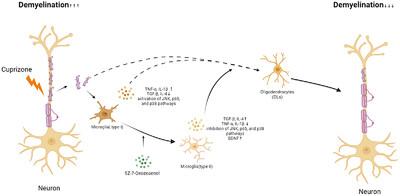当前位置:
X-MOL 学术
›
Brain Behav.
›
论文详情
Our official English website, www.x-mol.net, welcomes your feedback! (Note: you will need to create a separate account there.)
5Z‐7‐Oxozaenol attenuates cuprizone‐induced demyelination in mice through microglia polarization regulation
Brain and Behavior ( IF 3.1 ) Pub Date : 2024-04-22 , DOI: 10.1002/brb3.3487 Shiyu Chen 1, 2 , Siyao Liu 2 , Yalun Huang 1 , Shiwen Huang 1 , Wanzhou Zhang 1 , Huifang Xie 1 , Lingli Lu 2
Brain and Behavior ( IF 3.1 ) Pub Date : 2024-04-22 , DOI: 10.1002/brb3.3487 Shiyu Chen 1, 2 , Siyao Liu 2 , Yalun Huang 1 , Shiwen Huang 1 , Wanzhou Zhang 1 , Huifang Xie 1 , Lingli Lu 2
Affiliation

|
IntroductionDemyelination is a key factor in axonal degeneration and neural loss, leading to disability in multiple sclerosis (MS) patients. Transforming growth factor beta activated kinase 1 (TAK1) is a critical molecule involved in immune and inflammatory signaling pathways. Knockout of microglia TAK1 can inhibit autoimmune inflammation of the brain and spinal cord and improve the outcome of MS. However, it is unclear whether inhibiting TAK1 can alleviate demyelination.MethodsEight‐week‐old male c57bl/6j mice were randomly divided into five groups: (a) the control group, (b) the group treated with cuprizone (CPZ) only, (c) the group treated with 5Z‐7‐Oxozaenol (OZ) only, and (d) the group treated with both cuprizone and 15 μg/30 μg OZ. Demyelination in the mice of this study was induced by administration of CPZ (ig) at a daily dose of 400 mg/kg for consecutive 5 weeks. OZ was intraperitoneally administered at mentioned doses twice a week, starting from week 3 after beginning cuprizone treatment. Histology, rotarod test, grasping test, pole test, Western blot, RT‐PCR, and ELISA were used to evaluate corpus callosum demyelination, behavioral impairment, oligodendrocyte differentiation, TAK1 signaling pathway expression, microglia, and related cytokines.ResultsOur results demonstrated that OZ protected against myelin loss and behavior impairment caused by CPZ. Additionally, OZ rescued the loss of oligodendrocytes in CPZ‐induced mice. OZ inhibited the activation of JNK, p65, and p38 pathways, transformed M1 polarized microglia into M2 phenotype, and increased brain‐derived neurotrophic factor (BDNF) expression to attenuate demyelination in CPZ‐treated mice. Furthermore, OZ reduced the expression of proinflammatory cytokines and increases anti‐inflammatory cytokines in CPZ‐treated mice.ConclusionThese findings suggest that inhibiting TAK1 may be an effective approach for treating demyelinating diseases.
中文翻译:

5Z-7-Oxozaenol 通过小胶质细胞极化调节减轻铜宗诱导的小鼠脱髓鞘
简介脱髓鞘是轴突变性和神经损失的关键因素,导致多发性硬化症 (MS) 患者残疾。转化生长因子 β 激活激酶 1 (TAK1) 是参与免疫和炎症信号通路的关键分子。敲除小胶质细胞 TAK1 可以抑制大脑和脊髓的自身免疫炎症,改善 MS 的预后。然而,尚不清楚抑制TAK1是否可以减轻脱髓鞘。方法将8周龄的雄性c57bl/6j小鼠随机分为五组:(a)对照组,(b)仅用铜宗(CPZ)治疗组,( c) 仅用 5Z-7-Oxozaenol (OZ) 治疗的组,以及 (d) 同时用铜宗和 15 μg/30 μg OZ 治疗的组。本研究中的小鼠脱髓鞘是通过连续 5 周每日剂量 400 mg/kg 施用 CPZ (ig) 来诱导的。从开始铜宗治疗后第 3 周开始,每周两次按上述剂量腹膜内施用 OZ。采用组织学、转棒试验、抓握试验、杆试验、Western blot、RT-PCR和ELISA来评估胼胝体脱髓鞘、行为障碍、少突胶质细胞分化、TAK1信号通路表达、小胶质细胞和相关细胞因子。防止 CPZ 引起的髓磷脂损失和行为障碍。此外,OZ 挽救了 CPZ 诱导小鼠少突胶质细胞的损失。 OZ 抑制 JNK、p65 和 p38 通路的激活,将 M1 极化小胶质细胞转化为 M2 表型,并增加脑源性神经营养因子 (BDNF) 表达,以减轻 CPZ 治疗小鼠的脱髓鞘作用。此外,OZ 降低了 CPZ 治疗小鼠促炎细胞因子的表达并增加了抗炎细胞因子的表达。结论这些发现表明,抑制 TAK1 可能是治疗脱髓鞘疾病的有效方法。
更新日期:2024-04-22
中文翻译:

5Z-7-Oxozaenol 通过小胶质细胞极化调节减轻铜宗诱导的小鼠脱髓鞘
简介脱髓鞘是轴突变性和神经损失的关键因素,导致多发性硬化症 (MS) 患者残疾。转化生长因子 β 激活激酶 1 (TAK1) 是参与免疫和炎症信号通路的关键分子。敲除小胶质细胞 TAK1 可以抑制大脑和脊髓的自身免疫炎症,改善 MS 的预后。然而,尚不清楚抑制TAK1是否可以减轻脱髓鞘。方法将8周龄的雄性c57bl/6j小鼠随机分为五组:(a)对照组,(b)仅用铜宗(CPZ)治疗组,( c) 仅用 5Z-7-Oxozaenol (OZ) 治疗的组,以及 (d) 同时用铜宗和 15 μg/30 μg OZ 治疗的组。本研究中的小鼠脱髓鞘是通过连续 5 周每日剂量 400 mg/kg 施用 CPZ (ig) 来诱导的。从开始铜宗治疗后第 3 周开始,每周两次按上述剂量腹膜内施用 OZ。采用组织学、转棒试验、抓握试验、杆试验、Western blot、RT-PCR和ELISA来评估胼胝体脱髓鞘、行为障碍、少突胶质细胞分化、TAK1信号通路表达、小胶质细胞和相关细胞因子。防止 CPZ 引起的髓磷脂损失和行为障碍。此外,OZ 挽救了 CPZ 诱导小鼠少突胶质细胞的损失。 OZ 抑制 JNK、p65 和 p38 通路的激活,将 M1 极化小胶质细胞转化为 M2 表型,并增加脑源性神经营养因子 (BDNF) 表达,以减轻 CPZ 治疗小鼠的脱髓鞘作用。此外,OZ 降低了 CPZ 治疗小鼠促炎细胞因子的表达并增加了抗炎细胞因子的表达。结论这些发现表明,抑制 TAK1 可能是治疗脱髓鞘疾病的有效方法。



























 京公网安备 11010802027423号
京公网安备 11010802027423号